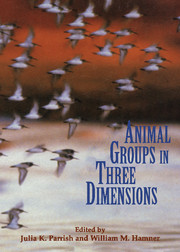Book contents
- Frontmatter
- Contents
- List of contributors
- Acknowledgments
- 1 Introduction – From individuals to aggregations: Unifying properties, global framework, and the holy grails of congregation
- Part one Imaging and measurement
- Part two Analysis
- Part three Behavioral ecology and evolution
- Part four Models
- 16 Conceptual and methodological issues in the modeling of biological aggregations
- 17 Schooling as a strategy for taxis in a noisy environment
- 18 Trail following as an adaptable mechanism for popular behavior
- 19 Metabolic models of fish school behavior – the need for quantitative observations
- 20 Social forces in animal congregations: Interactive, motivational, and sensory aspects
- References
- Subject index
- Taxonomic index
20 - Social forces in animal congregations: Interactive, motivational, and sensory aspects
from Part four - Models
Published online by Cambridge University Press: 01 June 2010
- Frontmatter
- Contents
- List of contributors
- Acknowledgments
- 1 Introduction – From individuals to aggregations: Unifying properties, global framework, and the holy grails of congregation
- Part one Imaging and measurement
- Part two Analysis
- Part three Behavioral ecology and evolution
- Part four Models
- 16 Conceptual and methodological issues in the modeling of biological aggregations
- 17 Schooling as a strategy for taxis in a noisy environment
- 18 Trail following as an adaptable mechanism for popular behavior
- 19 Metabolic models of fish school behavior – the need for quantitative observations
- 20 Social forces in animal congregations: Interactive, motivational, and sensory aspects
- References
- Subject index
- Taxonomic index
Summary
Introduction
Until relatively recent times there has been a strong tendency for studies of animal congregations to emphasize the properties of the group rather than the fact that all such groups are composed of independent individuals (Pitcher & Parrish 1993). This is partly because the collection of data from identified members of dynamic, often large, and three-dimensional groups is not a straightforward matter. However, since natural selection operates mainly upon the individual, it is important to develop interpretations on the structure-function relationships of groups in terms of the imperatives and constraints which impinge on individuals (Magurran 1993).
To this end, it is relevant to consider how social interactions and whole-group dynamics are influenced by changes in the motivational state of individuals in response to internal and external factors. This raises questions concerning the types of information to which congregating individuals respond, as well as the translation mechanisms which mediate between sensory inputs and emergent behavior. Motivational analyses can therefore provide a framework within which the highly dynamic changes in an animal's internal state, themselves affected by a wide range of external factors, may be used to interpret group processes.
A central aim in attempts to assess the fitness consequences of group cohesion and coordination must be an appreciation of the mechanisms whereby members of a group interact. In other words, understanding how animals group can help us understand why they do so (Partridge et al. 1980). As with other behaviors, an instructive approach is to pose questions regarding the number of internal causal factors which underlie the behavior, how they interact, how they are affected by external cues, and how they change over time (Colgan 1993).
- Type
- Chapter
- Information
- Animal Groups in Three DimensionsHow Species Aggregate, pp. 313 - 336Publisher: Cambridge University PressPrint publication year: 1997
- 6
- Cited by



